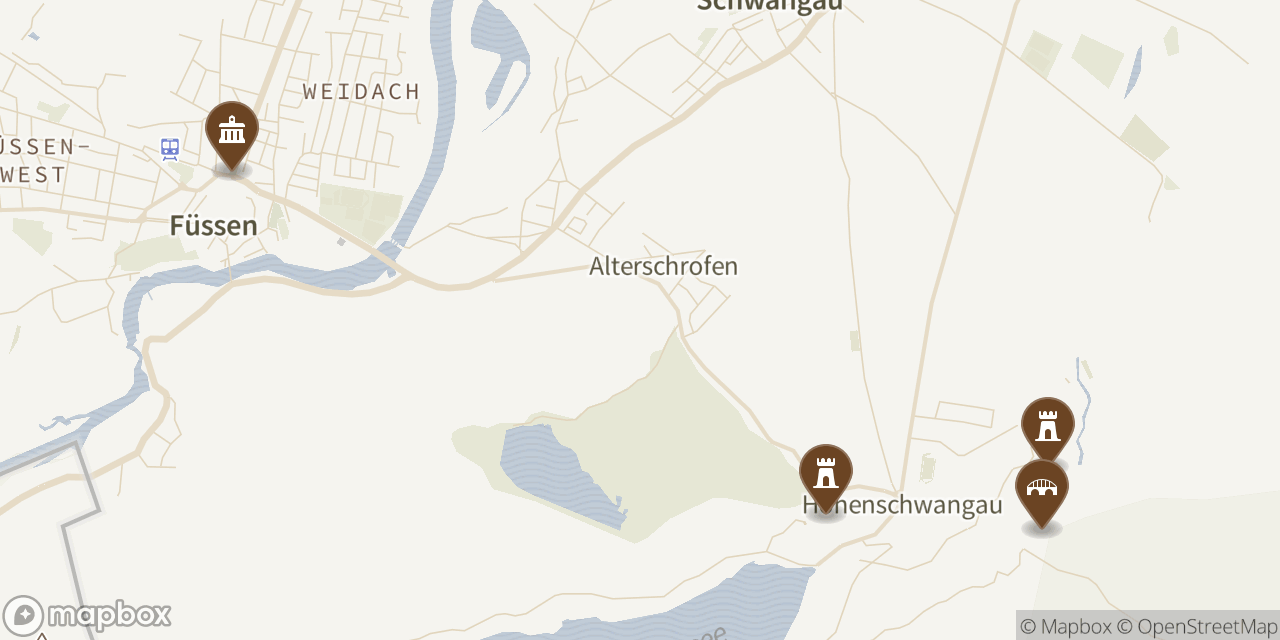Experience Germany's most famous fairy tale castle
Discover scenic hiking trails and the Marienbrücke viewpoint
Explore the charming medieval town of Füssen
Visit both Neuschwanstein and Hohenschwangau castles
Why We Love This Trip
Interactive Map

Points of Interest
Your Day Trip Timeline
Depart Munich
Take early morning train to Füssen (2 hours) - Sit on left side for best views
Arrive in Füssen
Catch synchronized bus to castle area
Use facilities
Use train bathroom before arrival - avoid paid toilets in Füssen
Collect tickets
Pick up pre-booked tickets at visitor center (90 mins before tour)
Walk to castle
30-minute uphill walk or horse carriage ride
Castle tour
45-minute guided tour of 15 completed rooms
Marienbrücke viewpoint
Walk to suspension bridge for classic photo spot and gorge views
Explore hiking trails
Follow marked paths around castle grounds for unique photo angles
Hohenschwangau Castle
Visit Ludwig II's childhood home and summer residence
Explore Füssen
Walk medieval high street with painted buildings and murals
River walk
Stroll along Lech River (Altsee)
Visit monastery
Climb to hilltop monastery for mountain views
Historical center
Learn about Füssen's luthier history and violin-making tradition
Return journey
Evening train back to Munich
Ben's Deep Dive
Beyond the fairy tale facade lies a fascinating story of 19th-century German romanticism and a king's obsession with medieval ideals that shaped one of Bavaria's most enduring attractions.
The story of Neuschwanstein Castle is deeply intertwined with Germany's 19th-century cultural awakening and the peculiar vision of King Ludwig II of Bavaria. What makes this German castle particularly fascinating is its timing—construction began in 1869, well past the era when castles served any practical military purpose.
This wasn't an oversight but rather a deliberate choice that reflects the broader German Romantic movement of the time. German culture in the mid-1800s was completely preoccupied with romanticized notions of the Middle Ages, with nobles across the region renovating buildings and undertaking new projects to create picturesque versions of their medieval history.
King Ludwig II was absolutely no exception, and Neuschwanstein represents the ultimate expression of this cultural phenomenon.
The castle's location above the Alpine town of Füssen in southern Bavaria, right next to the Austrian border, was carefully chosen by Ludwig to maximize both the dramatic setting and his personal connection to the area. He had spent his childhood summers at nearby Hohenschwangau Castle, which his father had purchased in 1832 and restored from a previously dilapidated fortress dating back to the 12th century.
Upon his father's death, Ludwig took up full-time residence in Hohenschwangau, and it was from this base that he began planning his dream castle. The contrast between the two castles near Munich Germany is striking—while Hohenschwangau maintains its lived-in, historically authentic atmosphere, Neuschwanstein was designed purely as a fantastical retreat, making function completely subservient to form in a way that was quite strange for traditional castle architecture.
What many visitors don't realize is that Ludwig's vision was never fully realized. He moved into the palace as it neared completion in 1884, but mysteriously died while going out for a walk with his doctor in 1886, having lived in his magnificent creation for only 172 days.
Of the 200 rooms originally planned, only 15 were actually completed, which explains why the interior tour takes just 30 minutes despite the castle's imposing exterior. This incomplete state, rather than diminishing the castle's appeal, actually adds to its mystique and explains why many visitors find the exterior and surrounding landscape more compelling than the interior spaces.
The surrounding region offers layers of cultural and historical significance that extend far beyond the castle itself. Füssen, the closest town and train station, holds the distinction of being considered the cradle of lute-making, with the first lute makers' guild formed there in 1562.
During the height of the lute's popularity, up to 20 different luthiers worked in individual workshops throughout the town. As the lute fell out of fashion, the town's craftsmen adapted to violin-making, and hundreds of luthiers eventually emigrated elsewhere in Europe, spreading Füssen's influence to modern violin-making traditions.
The town also serves as a particularly emblematic example of the Romantic Road, the famous series of Bavarian villages connecting Würzburg and Füssen, decorated with beautiful painted buildings and murals that make it an ideal place to experience authentic Bavarian culture away from the castle crowds. The combination of this rich artisanal heritage, stunning Alpine setting, and medieval architecture creates a destination that offers far more depth than its fairy tale reputation might suggest.
Support Us
Plan Your Trip
Get personalized recommendations and custom itineraries for your Munich adventure. Whether you need help planning the perfect day trip, finding hidden gems, or creating a multi-day itinerary, we're here to make your Munich experience unforgettable.
| Consultation | Time |
|---|---|
| Quick Q&A | 20 min |
| Tailored Consultation | 45 min |
Join Our Tours
Experience Munich like a local with our personalized walking tours and full-day adventures! From hidden gems to local favorites, we'll show you the authentic side of Munich that most tourists miss.